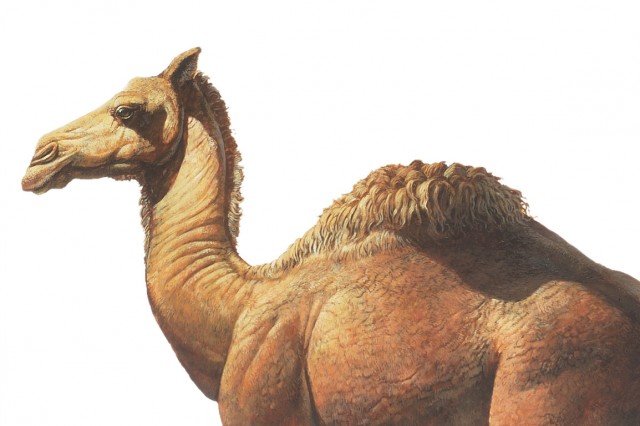
story
A new study reveals that human impacts in an environment made fire-prone by climate change and herbivore loss led to large mammals vanishing from southern California.
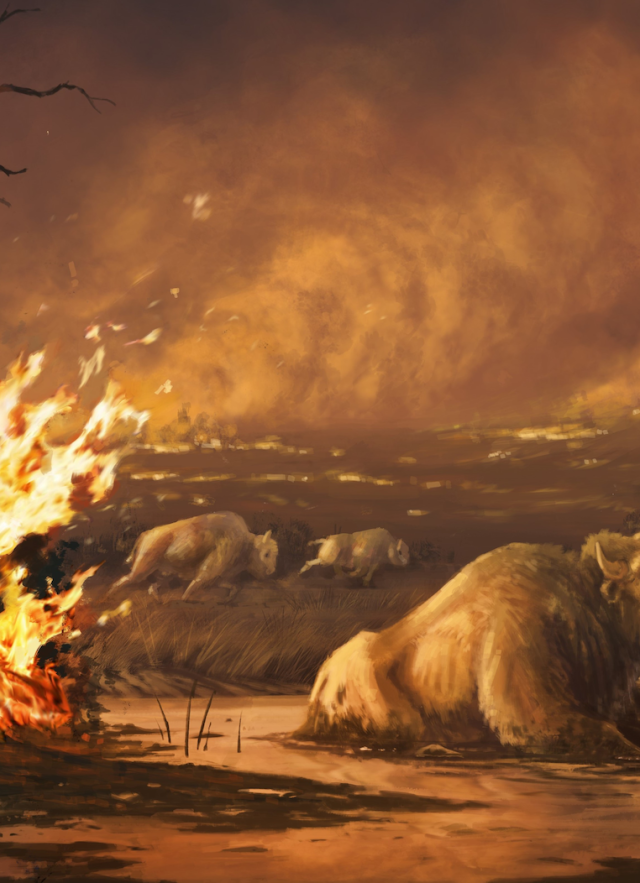
Published August 17, 2023
Around 12,700 years ago, North America lost 70 percent of its large mammals—a megafaunal extinction event paleontologists and archaeologists have been arguing over for more than half a century. Was it overhunting by spreading and growing human populations or environmental changes triggered by the end of the Ice Age?
In the region we now know as Southern California, large mammals like the saber-toothed cat and western camel vanished along with dozens of other species of “megafauna” (literally, large animals). Fortunately, Southern California also contains the best record of terrestrial Ice Age ecosystems anywhere on Earth: the dozens of asphalt-preserved fossil deposits in central Los Angeles known as La Brea Tar Pits.
Published in the journal Science, a new paper by researchers at La Brea Tar Pits compiles vast evidence—from mammal jawbones to pollen and charcoal records pulled from lake bottoms—revealing for the first time in detail the vanishing of once-ubiquitous megafauna and transformation of the Ice Age ecosystem. Their surprising findings turn the old humans vs. climate debate on its head: this extinction, they argue, was largely driven by human-caused fires in an ecosystem made vulnerable by rising temperatures, habitat change, and a centuries-long megadrought, an ominous parallel to challenges that humans are confronting on a planetary scale today.
“The megafaunal extinction at the end of the Ice Age was the biggest extinction event to happen since an asteroid slammed into Earth and wiped out all the large dinosaurs,” says co-author Dr. Emily Lindsey, Associate Curator and Excavation Site Director at La Brea Tar Pits. “The problem has been that nobody has been able to determine exactly when most of these big mammals actually disappeared because the fossil record is really spotty. It’s hard to say much about what caused an extinction if you don’t know when it happened.”
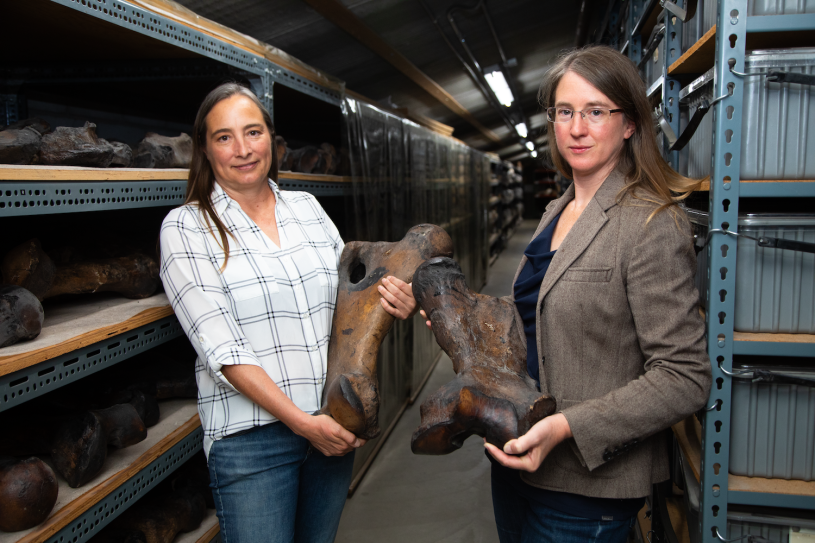
Using a method devised specifically for dating fossils preserved in asphalt, the research team of 19 scientists obtained more than 170 new radiocarbon dates on La Brea Tar Pits fossils, focusing on the eight most common large mammals: coyotes, horses, camels, bison, saber-toothed cats, giant ground sloths, American lions, and dire wolves. The fossil record at La Brea Tar Pits is unique because it comprises hundreds, and in some cases thousands, of animals of various species like saber-toothed cats, dire wolves, and horses. As the researchers found, it includes the last known living individual of five of these species from anywhere on the continent. But most importantly, this unparalleled record has allowed scientists for the first time ever to determine when different species disappeared from the ecosystem and start to ask: why?
Contradicting one popular theory, the fossils at La Brea show that the megafauna there disappeared at least 100 years before a sudden cold snap known as the Younger Dryas. This finding rules out both the Younger Dryas itself and a hypothetical meteor impact, invoked by some scientists to explain its sudden onset as culprits in the extinction.
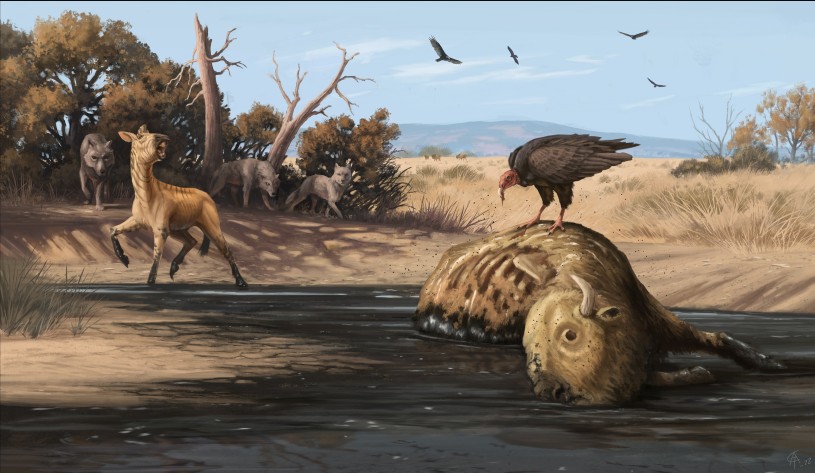
Instead, the researchers found that the Southern California extinction was more complex. Some animals disappeared earlier and the rest vanished simultaneously 13,000 years ago. Changing climates and plant communities helped the team unravel this complexity.
“This is the first time that we’ve really been able to link specific changes in the vegetation to the specific changes in the megafaunal populations,” says co-author Dr. Regan Dunn, paleobotanist and Assistant Curator at La Brea Tar Pits. ”What this research shows is that we have a direct link between a warming period, a total of 5.6ºC, but also drying, and so the effect of those two things together, the warming and the drying, really has the ecosystem changing from sort of a coniferous forest, sort of a woodland environment, to more of the chaparral, sort of the more open habitat and more arid taxa, and fire-prone taxa that we know today.”
To track changing climate and plant life, the researchers compiled data from a sediment core taken from the depths of nearby Lake Elsinore where pollen has accumulated over thousands of years, telling the story of vanishing trees. Pollen records describe a landscape of juniper and oaks. These trees gave way to pines, chaparral shrubs, and grass as the megadrought took hold.
Decreases in the amount of sand in the core pointed to less rainfall, and other chemical evidence suggests a drying lake and a rapidly warming climate. Even drought-tolerant junipers couldn’t last across seasons of extreme heat and dried-out soil. Tellingly, the pines, grass, and chaparral species that replaced them all share an important attribute—adaptation to fire.
While Southern California is a hotbed of wildfire activity today, most of these fires are caused by human activities—from downed power lines to runaway campfires. Natural, lightning-caused fires are exceedingly rare in these coastal regions. This appears to have been the case in the Pleistocene, too. Lisa Martinez, a PhD student at UCLA has reconstructed a fire history from charcoal fragments from Lake Elsinore. She found that before 13,250 years ago, fires in the region were extremely rare. But, following this, a burst of fires were sparked in what look to be large-scale—or “megafire” events. The timing of these conflagrations coincides with both a growing human population on the continent and the demise of the Rancho La Brea megafauna.
“At the point where we found the human population to really start to increase in North America, we see an interval of profound climatic and ecologic change coupled with unprecedented fire happening right here, and it's in this interval when all of the megafauna species disappear,” says Martinez.
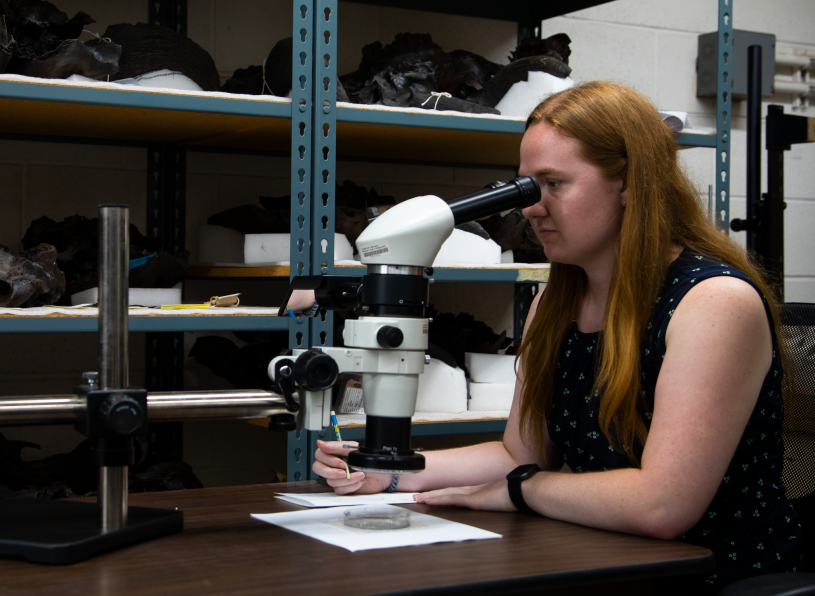
A partial skeleton of a man from Santa Rosa Island from the same time as the great peak in wildfires is the earliest definitive evidence of humans in California, (although abundant archaeological sites across the western United States suggest human presence by at least 15,000 years ago, and possibly much earlier). The Clovis people, once thought to have overhunted Pleistocene megafauna to extinction, arrived too late for lunch at the Tar Pits; the Clovis cultural complex is dated 13,050–12,750 years ago, almost entirely after the last Southern California sabertooth shuffled off this mortal coil.
While evidence of humans in the region is probably underwater or deeply buried, the team knew that human habitation likely preceded the sole individual from Santa Rosa. Compiling the most up-to-date records of human activity from North America, they modeled humanity’s demographic growth in the continent as a proxy for California in the region and then used a second model to compare this growth curve against changes in vegetation, fire activity, and megafaunal disappearance to investigate possible causal connections between the different extinction players.
Their model found a disastrous chain of ecological connections: a warming climate, reduction in tree pollen, and increase in human population all forecasted a decline in large herbivore numbers. The reduction in tree pollen also predicted an increase in fires. But the strongest relationship the scientists found by far was between human population growth and a large increase in fire activity.
“When humans arrive we see major changes in the frequency of fires and fire intensity,” says Dunn. “95 percent of the fires we see today are caused by anthropogenic sources from power lines or campfires that have gotten away, from highways or cigarettes or something like that. In a sense, we already know what happened, and what we learned from the past can help inform what will happen in the future and how better to plan to avoid ecosystem collapses.”
Almost 13,000 years after the extinction of saber-toothed cats and dire wolves, Southern California and the rest of the planet are bound in the same chain: human-caused climate change threatens to prolong droughts. Large mammals are increasingly under threat from climate change and human activities. And, wildfires caused by humans are getting larger and more frequent, and devastating more habitats and ecosystems.
“La Brea Tar Pits is pretty much the only place on Earth that has the data necessary to really look at what happened the last time we went through a significant climate change interval,” says Lindsey. “Understanding why these fires happened in the past and the impact they had on ecosystems can help land managers and planners today make decisions about how we can best preserve species, how we can best protect human property and human life, and how we can help our current human-dominated landscape transition into this new climate that we are entering.”
Sites like La Brea Tar Pits still have more to teach us about how understanding life in the prehistoric past can help inform how we approach conservation, but the window for avoiding a much larger ecological catastrophe could be closing fast, and we must act now.